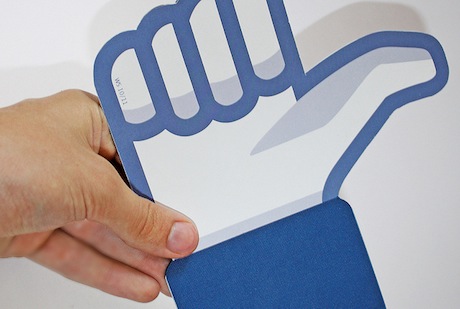Facebook Fan or Foe
As Facebook heads towards a record stock flotation that could value the company at £63 billion (and Mark Zuckerberg at £17.8 billion), we have to ask what role we, the users, play in its success.
The website relies on adverts to generate profit. Those can be directed either to an external website or to a branded Fan Page. Marketers realised early on that directing their ads to a Fan Page rather than a standard ‘Dot Com’, not only meant a better response (the site shared information about other friends who endorse the action), but also introduced the potential to grow massive marketing databases to which they could direct promotional messages at no further cost.
We’ve all swallowed the pill and a quick glance at your new timeline profile will show how many Fan Pages you have now ‘liked’- far more than you’d imagine, it’s not uncommon for single profiles to join hundreds a year.
The purpose of a Fan Page was never specifically defined by Facebook and companies have used them in a wide variety of mix-media campaigns. Conversion rates to ecommerce are low (much lower than email campaigns, Google AdWords or even banner adverts in most cases) but Social Media Managers have always insisted their value is in a form of public relations or “viral noise” as they like to call it.
Campaigns for High Street brand names have generated user-bases of millions, usually through clever call-outs for content to be shared or better still, comments to be left (analysis of successful pages show the more comments you have, the quicker you grow). Obscure posts have become common, with some companies simply sharing single words or crafty pictures to entice a response from their users. Every time we ‘like’ or ‘share’ a post, the Fan Page is exposed to our circle of friends, on average expanding the database by a potential 120 people per successful interaction.
The reward for the general public taking part in a Fan Page experience differs greatly from brand to brand. Discounts, vouchers and competitions are commonplace (despite most breaking the terms and conditions set out by Facebook) but more so is the expectation that fans will drive the growth of the database in return for a “feeling of belonging” or kinship.
Where the Fan Page falls down is when Fans become customers. Typically a Fan Page is administered by a marketing team with little or no contact with customer services, product managers or even PR departments, leaving the Fans a little ‘out of pocket’ when they turn to such places for assistance with their real world purchase.
Take for example a major fast food retailer with over 400,000 Fans on their UK page. Like most brands who offer online purchasing, their website provides a form of quick registration through a Facebook login. The theory is that we need not remember two passwords and can turn to the Fan Page for the latest updates, fun and games. Each new sign-up broadcasts their new found affiliation for the fast food provider to their peer group, the action appearing on the Facebook timeline or wall. If you have a question about your delivered pizza however (the core product the Fan Page advertises), users who raise this on the wall are met with a standard response along the lines of “please contact the store you bought from”.
Clearly, the channel is not considered an appropriate place for customer service, irrespective of the value each member brings to the party. Why offer discounts but no method of settling a complaint? Win some and lose some seems to be the accepted norm, an approach that must eventually fail in an ever connected, all-blogging world.
A quick check through a number of Fan Pages revealed a huge customer service gap. Some seem fully integrated with the notion that they represent a product and consumer, others far from it. When tested informally by this journalist, one of the UK’s biggest retailers Argos provided accurate, timely responses to simple product enquiries, adding information that wasn’t available in their catalogue and doing so within an hour. A frequently advertised credit card brand however not only failed to respond to the enquiry about the suitability of a product but seemingly deleted the post entirely, updating their current gift-giveaway competition as a higher priority.
It seems that in the world of Facebook Fan Pages, only happy Fans are welcome. If you have a question or indeed a complaint about the product you’re evangelising, the moderators are rarely empowered or trained to assist. With the base cost of installing a Facebook Fan Page being zero and the potential equivalent exposure for a successful page running into the £millions, this seems a rather unfair deal.
To be fair, this is more a symptom of having the wrong people in the wrong places than a deliberate step to abuse faith. No day goes by without a flurry of new Fan Pages fighting for our attention (Facebook states there are 600million ‘objects’ for us to interact with across the network), however the development and progression of these pages usually falls to an IT team (rarely experienced in the art of conversation management) or a marketing agency (infrequently connected to front-line sales). Only when the Fan Page becomes an integral, in-house department is this likely to change.
Next time you’re commenting on the photo of a cute puppy uploaded by Innocent Drinks people or telling Clinton’s who you’ll be sending a Valentine’s card to, flick the wall settings from “brand only” to “everybody” and see the level of customer-oriented response provided. If your fellow Fans are getting a bad deal, you may want to reconsider your role in future marketing efforts.
Fan or not, Facebook will feature in the marketing budgets of all lifestyle brands this year. For some, it will be the sole online spend in 2012, for others it may be a case of ‘have to be there’. To truly succeed however, the numbers involved will need to be analysed further and brand owners will need to ask a vital question- are your Fans actually customers?
Photo (cc) Johannes Fuchs



